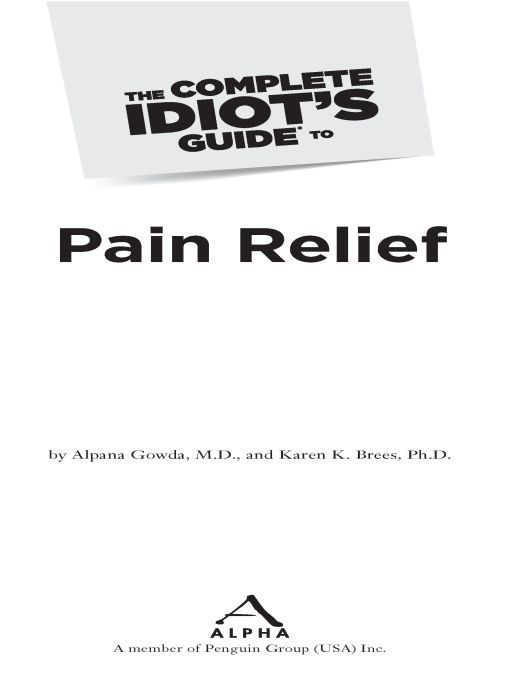Table of Contents
To my mother, Shail, who kissed every wound to make it feel better.
To my father, Raghava, who reached out his hand and helped me get up.
To my brother, Abhishek, who always kept me laughing.
ALPHA BOOKS
Published by the Penguin Group
Penguin Group (USA) Inc., 375 Hudson Street, New York, New York 10014, USA
Penguin Group (Canada), 90 Eglinton Avenue East, Suite 700, Toronto, Ontario M4P 2Y3, Canada (a division of Pearson
Penguin Canada Inc.)
Penguin Books Ltd., 80 Strand, London WC2R 0RL, England
Penguin Ireland, 25 St. Stephens Green, Dublin 2, Ireland (a division of Penguin Books Ltd.)
Penguin Group (Australia), 250 Camberwell Road, Camberwell, Victoria 3124, Australia (a division of Pearson Australia Group Pty. Ltd.)
Penguin Books India Pvt. Ltd., 11 Community Centre, Panchsheel Park, New Delhi110 017, India
Penguin Group (NZ), 67 Apollo Drive, Rosedale, North Shore, Auckland 1311, New Zealand (a division of Pearson New Zealand Ltd.)
Penguin Books (South Africa) (Pty.) Ltd., 24 Sturdee Avenue, Rosebank, Johannesburg 2196, South Africa
Penguin Books Ltd., Registered Offices: 80 Strand, London WC2R 0RL, England
Introduction
As a doctor, my purpose is to provide my patients with the best care possible. Each of my patients is an individual, and that means that the needs of each of my patients with pain differ. Those with acute pain must be treated differently from patients with chronic pain. For patients with chronic pain, treatment means a multidisciplinary system with the goal of restoring function and improving that patients ability to function in everyday life.
Education is key to understanding pain and how it works in your life. In this book youll find the information you need to become an educated consumer of health-care services.
Research has given us many new tools to manage pain more effectively. This means that if oral medications arent providing you with relief, other options are available to you. Research continues, and every year we make significant advances in treating pain.
Pain relief is a team effort. It involves you, your physician, your surgeon, your physical therapist, and in many cases, a counselor trained to provide cognitive behavioral therapy that can help you achieve control of your pain issues.
Pain relief truly requires a multidisciplinary approach. As you read this book, youre looking for answers to your questions. How do you treat acute pain? How do you live with chronic pain? Weve tried to provide helpful information that addresses your concerns.
You cant go it alone. Take advantage of the resources available to you and reach out to take the hand of those ready, willing, and able to help. Become an active participant in your own pain-relief therapies.
Use this book as a guide. Learn from it and then talk with your doctor about your concerns. Educate yourself about your medical condition. You are the person who knows you best. There is help for you, whatever your diagnosis.
How This Book Is Organized
This book is designed to be a head to toe primer on pain relief. From diagnosis through treatment and prevention, let this book be your guide and companion.
Part 1, Understanding Pain, tells you what pain is, how it works, and what you need to know so youre prepared to confront it head on.
Part 2, Diagnosing and Treating Pain, walks you through the various tests and procedures that can help you home in on pain.
Part 3, Pain from Head to Toe, takes you on a tour of your body, showing you how pain works in every place and what you can do about it.
Part 4, The Broader Picture of Pain, explains what happens when pain becomes an illness of its own.
Extras
This book includes four different types of sidebars to enhance your understanding of pain relief. Look for these boxes:
DEFINITION
Understanding medical language can be difficult. Here are definitions and explanations of medical terms used in this book.
POINTERS ON PAIN
Here youll find additional important tips and information on managing pain.
STABS AND JABS
Cautions and concerns to be aware of.
SPEAKING OF PAIN
Good information on pain facts and stats.
Acknowledgments
Id like to pay tribute to my mentors from The Ohio State University and Stanford University. My training in Physical Medicine and Rehabilitation and Pain Management has taught me to think outside the box. I am humbled by their continued interest in my learning.
Trademarks
All terms mentioned in this book that are known to be or are suspected of being trademarks or service marks have been appropriately capitalized. Alpha Books and Penguin Group (USA) Inc. cannot attest to the accuracy of this information. Use of a term in this book should not be regarded as affecting the validity of any trademark or service mark.
Part 1
Understanding Pain
Pain is an unwelcome part of the human experience. Whether the result of an injury or a component of an underlying medical condition, pain makes life uncomfortable. While we all hope for a cure for pain, sometimes the best we can do is learn to manage it and reduce its impact on our daily lives.
In Part 1, well take an in-depth look at what pain is, how it works, and how its measured. Everyones experience with pain is unique, and well discuss how best to communicate your pain experience to your physician.
Chapter 1
Pain Basics
In This ChapterComing to terms with pain
How pain works
Your brain and pain
Rethinking pain
What exactly is pain? Science has some surprising answers to that question. Beginning with the search for a definition, researchers have broadened their scope to seek clues to what causes pain, how the body and the brain recognize pain, and what happens when pain doesnt go away. In this chapter, well examine the cycle of pain, learn something about its underlying nature, and discuss the different approaches for treating acute and chronic pain.
Defining Pain
Before you can figure out how something works, you need to define what it is. That may seem like a simple enough task, but pain is something that can be difficult to accurately define in a few words or even in a paragraph.
Many folks have taken a stab at defining pain. One of the most widely used definitions is the one used by the International Association for the Study of Pain. Theyve defined pain as an unpleasant sensory and emotional experience arising from actual or potential tissue damage or described in terms of such damage.










